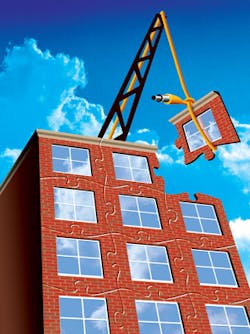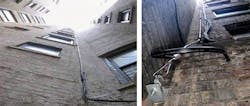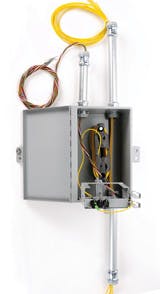Solving the MDU puzzle
Three elements should be considered to determine the best way to cable a multi-dwelling unit.
If “every MDU is different,” then those responsible for cabling a multi-dwelling unit (MDU) as part of a fiber to the home (FTTH) deployment would seem to face a monumental task. Greenfield MDUs tend to be relatively simple, since FTTH cabling is installed at the same time as other wiring. The challenge comes with existing buildings (brownfield applications) that may not have sufficient vertical riser pathway space and may require installing horizontal pathway systems in hallways.
Before identifying the technologies that will work well in brownfield MDU deployments, it’s helpful to categorize MDUs, since the term can be used to describe buildings sized from a duplex to a skyscraper. The categorization can be as complex as the network designer desires, but there are at least three considerations that can help capture the majority of MDUs:
- Building size (number of floors and number of living units per floor).
- Inside or outside deployment of the riser cables.
- Pre-connectorized or field-terminated cabling.
How big is it?
The first and most obvious way to categorize an MDU is by size. Small, medium, and large are basic classifications that can be used – but what makes an MDU one size versus another?
Small MDUs are generally one to three stories, and they’re typically cabled the same way as single dwelling units, which means single-fiber drop cables are run independently to each living unit. This approach is referred to as a “direct-drop solution.” Duplexes and MDUs in which all units share the ground floor can easily be cabled with single-fiber drop cables from a consolidation point; but even MDUs up to four stories can be candidates for a direct-drop approach.
Medium-sized MDUs are typically four to 10 stories tall. They are more likely to have a telecom room or space in the basement that contains a demarcation point between the incoming feeder cable and the rest of the MDU cabling. Whether the MDU contains a fiber distribution hub (FDH) and splitters will depend on the total number of living units and the overall system architecture.
Large MDUs are typically more than 10 stories, but an MDU with fewer than 10 floors could be considered large if it has more than eight living units per floor. A large MDU will have a dedicated FDH (outdoor or indoor) and splitters to service the building.
As implied, another consideration in classifying the size of an MDU is the number of living units per floor. Compare, for example, a four-story MDU with 12 living units per floor versus a four-story MDU with only four living units per floor. The MDU with 12 living units per floor is a straightforward medium-sized MDU design that will benefit from having a multifiber horizontal-cable assembly run down each hallway and connected to a multifiber riser cable through a riser terminal. However, the MDU with four living units per floor may not have a traditional hallway on each floor and may lend itself to a direct-drop solution.
Thus there are no absolute definitions for MDU size, and there will be overlap between the categories based on a specific MDU’s characteristics. But such classification enables designers to start creating solution sets for various types of MDUs.
Inside or outside?
The second factor in determining the right MDU cabling approach is placement of the riser cables. While it seems natural to place the riser cables in an indoor riser shaft, the option to place cabling outside should not be discounted. For instance, older MDUs may not have an adequate internal riser pathway. One option in this scenario is to install a new pathway by drilling through each floor. That’s clearly expensive and time-consuming. Moving the riser cable outside the building onto the “facade” can be an attractive alternative.
There are many MDUs that are prime candidates for placing cables externally because the sides or back of the building are hidden from general view. In addition, many MDUs already have power or older telecom cables on the building facade.
In external deployment cases where the cables may be considered unsightly, the cables can be hidden with molding systems, which can be molded in color, painted to match the facade, or even designed to look like rain gutters. These molding systems also provide an additional layer of physical protection.
Successful installation of the vertical cabling component outside requires products that are built for outdoor applications (e.g., water-blocked and UV-stabilized jackets). Three options are available for facade deployments:
- Single-fiber OSP drop cables. In this direct-drop solution, each cable independently runs vertically and horizontally along the building facade from a distribution terminal to the living unit. This approach works especially well for MDUs of up to three floors.
- Bundled single-fiber cables. Single-fiber drop cables are bundled together by the manufacturer and staggered at standard intervals (i.e., the distance between floors). The living unit end of each cable is factory-terminated with a connector (typically SC APC). The assembly is hung vertically on the side of the building so each cable in the bundle lines up with a living unit. These bundled products are meant to feed one living unit on each floor. For example, if an MDU has four living units per floor, then four vertical bundled assemblies would be needed. This approach works well for MDUs of up to six floors and when there are not many living units per floor (ideally four or less).
- Pre-engineered multifiber-connector cable assemblies. Uses multifiber cable with fibers accessed in the factory at standard intervals (again, the distance between floors). Fibers at each access point are confined within a tether. The end of the tether is terminated with a multifiber connector containing up to 12 fibers. The connector then plugs into a hallway cable assembly that feeds each living unit. This approach works well for MDUs up to 12 floors and up to 12 living units per floor. MDUs with more than 12 living units per floor would require more than one pre-engineered vertical-cable assembly.
New developments in interior riser pathways
If an interior riser pathway is available, MDU-specific plug-and-play products that remove most or all splicing not only speed deployment, but also require minimal fiber experience from the installation technicians.
In a basic scenario, a riser terminal is located on each floor. The terminal provides connectivity between pre-connectorized riser cables and pre-connectorized horizontal hallway cables. In a fully connectorized system, the riser cable (with factory terminations on each end) is pulled up or down the riser pathway and plugged into the riser terminal on the floor level and into the indoor FDH in the basement. Although one riser cable may be needed for each floor, the riser cables can be very small in diameter (i.e., 0.14 inch/3.5 mm) and contain 12 or 24 fibers for the floor. Many of these riser cables can be installed in small pathways such as 1.25-inch conduit.
Slack storage
Although fully connectorized plug-and-play products can greatly speed deployment, the biggest obstacle to their use is managing excess cable. It takes accurate measurements – plus a little added for safety – to ensure the assembly does not come up short. In addition, custom lengths tend to have longer manufacturing times and the installation crews must take extra care to ensure that the correct assembly is installed on each floor.
Fortunately, manufacturers have developed clever products that solve these problems. The riser assemblies are packaged on collapsible reels or spinning spools that allow payoff of the exact length of cable needed. The remaining cable stays permanently stored on the hardware. That allows the service provider to stock a small set of product configurations that will meet the great majority of MDU needs.
Hallway deployments
Most medium and large MDU buildings have a hallway on each floor – which is where horizontal cabling will be placed to “pass” each living unit. Many brownfield MDUs will require horizontal cabling to be placed in a molding system to protect and hide the cables. There are many types of plastic molding systems from very utilitarian to decorative. In older MDUs, such a molding system probably is already in place. As long as there’s room, the new horizontal fiber cable assemblies can be placed inside this molding.
For simplicity, multifiber horizontal cables can be pre-connectorized on the end that will plug into the riser terminal. The fibers on the connectorized end may be terminated with single-fiber connectors or multifiber MPO connectors for fast connection and to reduce hardware size requirements. In addition, these connectors are increasingly available in low-loss versions (<0.35 dB) and with factory-cleaned and -sealed configurations that require no cleaning on initial mating, making for a true plug-and-play installation.
The downstream end (living unit) of the horizontal-cable assembly is not pre-terminated so to enable the installer to terminate the fiber at the desired location. Termination can be completed by installing a no-epoxy/no-polish field-installable connector or by splicing on a short connectorized pigtail.
Once the fiber is terminated, the living unit is officially “passed.” When a tenant requests service, a hole is drilled into the living unit and a jumper is installed from the hallway connector to the ONT or fiber wall outlet inside the living unit.
In the basement
The last segment of the MDU installation is the transition from the riser cables to the field distribution cable. The number of living units in an MDU and the system architecture will generally determine whether splitters will be installed at the MDU or further upstream in the network. Large MDUs may contain indoor FDH cabinets that can house splitters. In smaller MDUs, more compact splitter boxes containing smaller splitters (e.g., 1×4) work well for distributed split architectures.
MPO connector technology has also found its way into indoor FDH cabinets. The multifiber riser cables can be equipped with MPO connectors on the basement end to plug directly into the indoor FDH. Fully connectorized splitter modules for fast splitter installation complete the plug-and-play product set.
Splicing vs. pre-connectorized cables
A final aspect to consider is labor. When skilled labor and fusion splice machines are available, a totally spliced system can make sense. Note, however, that the installation is likely to take longer than a pre-connectorized system would require. In these situations, non-MDU-specific components can also be used.
When skilled labor and fusion splice machines are not available, speed of deployment is critical, or the disruption of adding service to a tenant is important, factory pre-connectorized cabling can provide a simple way to quickly cable an MDU.
Spliced cables may involve single-fiber splicing, as with the direct-drop solutions for small MDUs or ribbon splicing in larger MDUs. In the larger MDUs, the internal riser may be a single high-fiber-count riser cable that is mid-span accessed on each floor for splicing to the horizontal cables. Another option is to install multiple riser cables – one to each floor or one feeding multiple floors – and splicing to the horizontal cables.
Putting it all together
Now that we have created categories of MDUs and identified products tailored for them, a matrix such as the one in the Table can help the designer select appropriate options for each MDU encountered.
Although every MDU may be different, it’s possible to group them into general categories with MDU-specific products and solution sets created for each category. By applying the principles discussed here, anyone can use their own criteria for classifying MDUs and the products they prefer to create a similar matrix that will address the great majority of MDUs in their network.
MICHAEL WATSON is a systems specialist and STEVEN COLBY a premises installation specialist at Corning Cable Systems.





